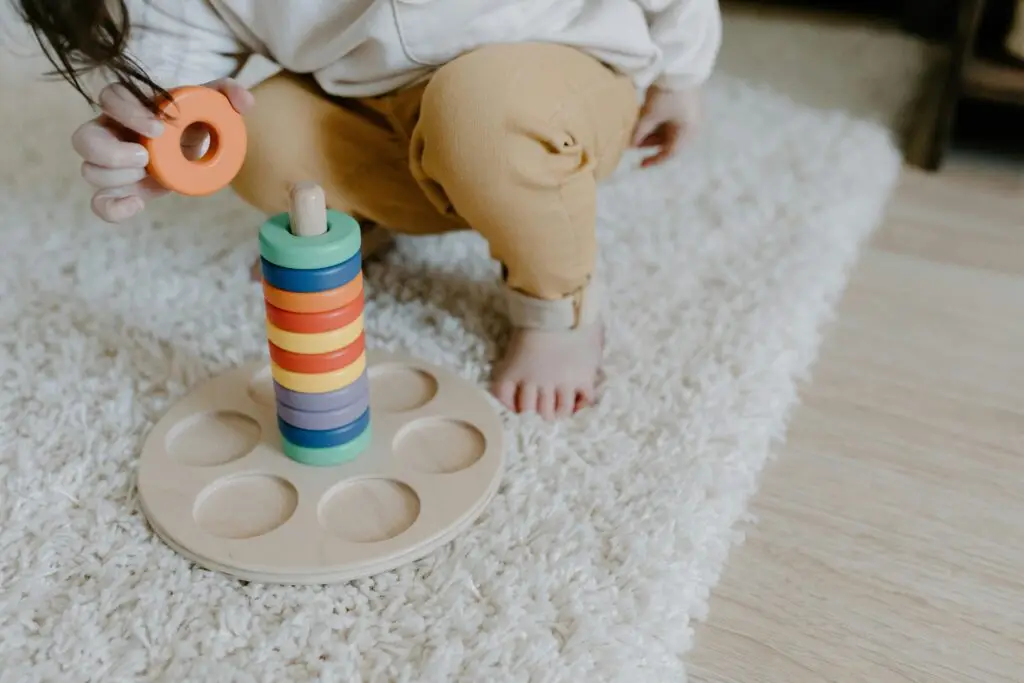The 8 Best Montessori Toys for 1-Year-Olds
In the formative years of a child’s life, play serves as a cornerstone for development. As parents and caregivers, selecting the right toys can significantly influence a child’s growth and learning. Montessori toys, inspired by the Montessori approach to education, are designed to support a child’s natural curiosity and promote independent exploration. In this article, we’ll delve into the world of Montessori toys specifically tailored for 1-year-olds, highlighting their developmental benefits and why they’re essential for early learning.

This post contains affiliate links (at no cost to you). Learn more
Understanding Montessori Principles for 1-Year-Olds
Montessori education emphasizes hands-on learning, independence, and respect for a child’s natural development. For 1-year-olds, this means providing toys that encourage sensory exploration, fine motor skills, and cognitive growth. By engaging in purposeful play, children develop essential skills while fostering a love for learning from an early age.
Criteria for Selecting Montessori Toys
When choosing Montessori toys for 1-year-olds, simplicity, durability, and opportunities for exploration are paramount. These toys should be safe, engaging, and capable of stimulating multiple senses simultaneously. By selecting toys that align with a child’s developmental stage and interests, caregivers can maximize their learning potential during playtime.
The Top 8 Montessori Toys for 1-Year-Olds
1. Wooden Shape Sorter
Transitioning from the exploration of textures and sounds, 1-year-olds begin to develop fine motor skills and shape recognition. A wooden shape sorter offers the perfect opportunity for tactile exploration and cognitive growth as children match shapes to corresponding slots. As they successfully fit each shape, children experience a sense of accomplishment, boosting their self-confidence and fostering a positive attitude towards learning.
2. Sensory Balls Set
Sensory exploration is vital for early childhood development, and a sensory ball set provides a variety of textures, colors, and sizes for 1-year-olds to explore. By engaging their senses, children enhance their cognitive abilities and develop sensory integration skills. Furthermore, rolling, throwing, and grasping the balls encourage gross motor development, supporting physical coordination and muscle strength.
3. Montessori Object Permanence Box
Understanding object permanence is a crucial milestone for 1-year-olds. The Montessori object permanence box teaches this concept through hands-on exploration, as children delight in discovering objects hidden within the box. As they repeatedly play with the box, children strengthen their memory and problem-solving skills, laying a foundation for more complex cognitive tasks in the future.
4. Wooden Stacking Rings
As 1-year-olds refine their grasping and hand-eye coordination skills, wooden stacking rings offer a stimulating challenge. By stacking rings of varying sizes, children enhance their spatial awareness and concentration while enjoying the satisfaction of completing a tower. Additionally, the bright colors of the rings capture their attention and encourage color recognition, further enriching their learning experience.
5. Wooden Sensory Blocks
Wooden sensory blocks offer endless possibilities for exploration and creativity. By manipulating blocks of different shapes, textures, and sizes, children develop fine motor skills and spatial reasoning while engaging their senses. As they build structures and experiment with stacking, children learn about balance, stability, and cause-and-effect relationships, promoting both cognitive and physical development.
6. Montessori Coin Box
Introducing basic numeracy concepts, the Montessori coin box encourages 1-year-olds to practice hand-eye coordination and numerical understanding. By placing coins into slots, children refine their fine motor skills while learning about cause and effect. Additionally, as they engage with the coin box, children develop an early understanding of quantity, numerical order, and spatial concepts, laying a foundation for mathematical thinking.
7. Nesting and Stacking Cups
Nesting and stacking cups provide versatile play opportunities for 1-year-olds. From simple stacking to imaginative play, these cups promote spatial awareness, problem-solving, and sensory exploration. As children nest the cups within each other or stack them into towers, they develop an understanding of size relationships, fine-tune their hand-eye coordination, and strengthen their grasp reflex, enhancing their overall dexterity.
8. Wooden Puzzle Set
Puzzles offer a satisfying challenge for 1-year-olds as they refine their problem-solving skills and shape recognition. A wooden puzzle set provides opportunities for independent play and cognitive growth as children complete simple puzzles. By manipulating puzzle pieces to fit into corresponding slots, children sharpen their spatial reasoning abilities, enhance their attention span, and gain a sense of accomplishment with each completed puzzle.
Investing in Montessori toys for 1-year-olds lays the foundation for lifelong learning and exploration. By providing opportunities for hands-on learning, sensory exploration, and cognitive growth, these toys support holistic development during this critical stage of childhood.
FAQ
- Are Montessori toys suitable for all 1-year-olds?
- While Montessori toys are designed to support early childhood development, individual preferences and interests may vary. It’s essential to observe your child’s reactions and adjust toy selections accordingly.
- How can I introduce Montessori toys to my 1-year-old?
- Start by presenting one toy at a time in a calm, uncluttered environment. Encourage exploration and provide gentle guidance as needed, allowing your child to engage with the toy at their own pace.
- What role do caregivers play in Montessori playtime?
- Caregivers serve as facilitators, providing support and encouragement while allowing children to lead their learning experiences. Offer praise, engage in meaningful interactions, and embrace the joy of discovery alongside your child.
